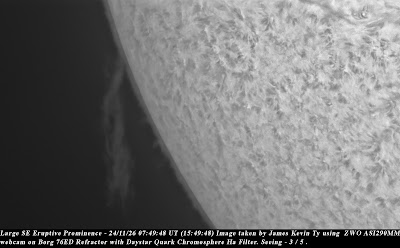Thursday, December 5, 2024
Deep Sky Imaging Session - December 5-6, 2024
The sky this evening is partly cloudy but the area in the constellation of Orion is clear so I quickly setup and start imaging but my luck runs out after 100 minutes of integration time as clouds started to cover almost the entire sky thus ending my session :( Nevertheless, I'm still happy with the result. I hope to be bale to image M42 again under a darker skies to get the molecular dust clouds even clearer. M42 Great Orion Nebula was taken using ZWO ASI294MC PRO Astro Camera on Borg 76ED Refractor with 0.8x Reducer / Flattener and STC AstroMultiSpectra Broadband Filter with total exposure of 100 minutes (100 x 60 sec) at -5 deg C.
Wednesday, November 27, 2024
Deep Sky Imaging Session - November 28, 2024
The sky this evening is clear and I revisited one of my old favorite, the majestic IC434 Horsehead Nebula in the constellation of Orion using ZWO ASI294MC PRO Astro Camera on Borg 76ED Refractor with 0.8x Reducer / Flattener and SVBony SV220 Duo Filter with total exposure of 120 minutes (60 x 120sec) at -5 deg C.
Deep Sky Imaging Session - November 27, 2024
The sky this evening is clear after I got home from a birthday party so I quickly setup to image again on M45 Pleiades star cluster as I was cut short by almost overcast sky after a short 25 minutes integration time only last session. I started right away after midnight but as soon as I started imaging, clouds again started to pester me in the early part but fortunately, after around 30 minutes past, the sky become clear again for me to continue my imaging session with M45 starting to gets lower into the western horizon. Although I was able to get about 2 hours worth of integration time, I decided to just use only 90 minutes as by the time I finish my imaging run, it was already hovering below 40 degrees. Nevertheless, I'm still happy to be able to get a better shot of M45 than my previous session. I also plan to image this again under the dark sky in Tanay to get better contrast and more nebulosity then what I'm imaging under the bad Bortle 8-9 sky in Manila.
Tuesday, November 26, 2024
Solar Imaging Session - November 26, 2024
The sky this late afternoon is partly cloudy but I was able to get a few shots of the Sun on AR3906 and AR3905 Region as well as a nice large SE Eruptive Prominence!
Saturday, November 23, 2024
Deep Sky Imaging Session - November 24, 2024
The sky after midnight was a bit clear so I quickly set up to image old favorites M45 Pleiades star cluster in the constellation of Taurus as well as M42 Great Orion Nebla in the constellation of Orion. My plans to capture these 2 beauties were cut short by sudden appearance of fast clouds that interrupted my imaging session thus I was only able to get a measly total integration time of only 25 minutes each... Nevertheless, results are still ok IMHO but of course it can improve further with longer integration time next imaging sessions. Anyway, both M45 & M42 were taken using ZWO ASI294MC PRO Astro Camera on Borg 76ED Refractor with 0.8x Reducer / Flattener and STC AstroMultiSpectra Broadband Filter with total integration of 25minutes each (25 x 60 sec) at -5 deg C.
Friday, November 22, 2024
Deep Sky Imaging Session - November 22, 2024
The sky this early evening is partly cloudy but cleared out in the mid evening time, I was able to recapture NGC7000 North American Nebula in the constellation of Cygnus with ample integrated exposure time this time around. Likewise, I also got a chance to capture M33 Triangulum Galaxy in the constellation of Triangulum as well. Both are imaged using ZWO ASI294MC PRO Astro Camera on Borg 76ED Refractor with 0.8x Reducer / Flattener. NGC7000 was captured using SVBony SV220 Duo Filter with total exposure of 60 minutes (30 x 120 sec) at -5 deg C while M33 was captured using STC AstroMultiSpectra Broadband Filter with total exposure of 60 minutes 60 x 60 sec) at -5 deg C.
Thursday, November 21, 2024
Deep Sky Imaging Session - November 21, 2024
The sky this evening is again clear so I take this opportunity to reimage NGC6992 Eastern Veil Nebula in the constellation of Cygnus as well as M31 Andromeda Galaxy in the constellation of Andromeda. Both were taken using ZWO ASI294MC PRO Astro Camera on Borg 76ED Refractor with 0.8s Reducer / Flattener. NGC6992 was taken using SVBony SV220 Duo Filter with a total exposure of 106 minutes (53 x 120 sec) at -5 deg C while M31 was taken with STC AstroMultiSpectra broadband Filter and a total exposure of 120 minutes (120 x 60 sec) at -5 deg C.
Tuesday, November 19, 2024
Deep Sky Imaging Session - November 19, 2024
The sky this evening is clear again so I use this opportunity to image IC1396 Elephant Trunk Nebula and NGC869/884 Double Cluster in the constellation of Cassiopeia despite the presence of Waning Gibbous Moon. I image the Elephant Trunk Nebula using ZWO ASI294MC PRO Astro Camera on Borg 76ED Refractor with 0.8x Reducer / Flattener and SVBony SV220 Duo Filter and total exposure of 60 minutes (30 x 120sec) at -5 deg C while the Double Cluster same setup except I use STC AstroMultiSpectra Broadband Filter with 60x 60sec exposure at -5 deg C.
Monday, November 18, 2024
Deep Sky Imaging Session - November 18-19, 2024
The sky this evening is clear despite the still large Waning Gibbous Moon phase, I still proceeded to image NGC281 Pacman Nebula in the constellation of Cassiopeia. Image was taken using ZWO ASI294MC PRO Astro Camera on Borg 76ED Refractor with 1x Flattener and SVBony SV220 Duo Filter. Total exposure of 120 minutes (60 x 120 sec) at -5 deg C.
Friday, November 15, 2024
Lunar Imaging Session - November 15, 2024
The sky this evening is hazy and with a Full Moon washing out the sky, I settled to imaging the Full Moon using ZWO ASI294MC PRO Astro Camera on Borg 76ED Refractor with 1x Flattener and SVBony SV220 Duo Filter. Exposure 0.036 sec at -5 deg C.
Deep Sky Imaging Session - November 15, 2024
The sky this evening is hazy but clear. But the early evening sky is already getting washed out by the super glow of the Full Moon rising early from the Eastern horizon. Since I'm going to test and check the new focus point of my camera with the added camera angle adjuster, I stubbornly proceeded with imaging the NGC 6992 Eastern Veil Nebula in the constellation of Cygnus knowing the bright Full Moon glare. I was able to capture it but with background gradients which I'm expecting to have. Yeah they are there but I'm still happy with the result but I will reimage this beauty next week after the typhoon has left the country. Image taken using ZWO ASI294MC PRO Astro Camera on Borg 76ED Refractor with 0.8x Reducer / Flattener and SVBony SV220 Duo Filter with 60 minutes total exposure (60 x 120 sec) at -5 deg C.
Saturday, November 9, 2024
Deep Sky Imaging Session - November 9-10, 2024
The sky this evening is slightly hazy but clear. I quickly setup early so that I can try to catch up with Western Veil Nebula in the constellation of Cygnus as ut is going to the NW horizon. I was able to get around 1.5 hours of data before i reached the 40 deg limit that I made for me before i will start to get bad light pollution and gradients.
After the Veil nebula, I went after the IC1848 Soul Nebula in the constellation of Cassiopeia with an ample 2 hrs data. Both images were taken using ZWO ASI294 MC PRO Astro Camera on Borg 76ED Refractor with 0.8x Reducer/ Flattener and SVBony SV220 Duo Filter. Total Exposure of 90 minutes (45 x 120 sec) and 120 minutes (60 x 120 sec) respectively at -5 deg C.


Friday, November 8, 2024
Deep Sky Imaging Session - November 9, 2024
The sky this early evening is cloudy and very hazy. But at around 11:30pm, the sky suddenly started to open up and I quickly setup to image the IC410 Tadpole Nebula in the constellation of Auriga, this is a nice pair with IC405 Flaming Star Nebula but my telescope and camera would not allow me to image them together in one field so I had to image them separately to complete my imaging session. I use my ZWO ASI294MC PRO Astro Camera on Borg 76ED Refractor with 0.8x Reducer / Flattener and SVBony SV220 Duo Filter to capture this nebula. Total exposure of 120 minutes (60 x 120sec) was taken at -5 deg C. I also make a Hubble Pallette version in HOO for this nebula to bring out more clearly the 2 tadpoles on the image.
Solar Imaging Session - November 8, 2024
The sky this afternoon is clear and seeing condition is good. It's been a while since I was able to do any solar imaging because I'm doing evening deep sky imaging and it is very exhausting doing both at the same time. Anyway, I was able to do solar imaging and image some nice large sunspot groups in AR3879, AR3883, AR3886 and AR3889 Regions. There are also 2 large prominences visible in the SE and Western limb.
Monday, November 4, 2024
Deep Sky Imaging Session - November 4, 2024
The sky this evening is partly cloudy but have numerous cloud openings that I proceeded to setup to try imaging Comet C/2023 A3 Tsuchinshan-Atlas but unfortunately, clouds doesn't want to cooperate even for a short while thus I opted to try imaging NGC7000 North American Nebula in the constellation of Cygnus. I initially thought I could get away to image this beautiful emission nebula but I ran out of luck as I was only able to image for 16 minutes before I got totally clouded out! :( Nevertheless, I'm still happy with the result even with such a very short integration time. NGC7000 North American Nebula was taken using ZWO ASI294MC PRO Astro Camera on Borg 76ED Refractor with 0.8x Reducer / Flattener and SVBony SV220 Duo Filter. Total exposure of 16 minutes (8 x 120 sec) at -5 deg C.
Subscribe to:
Comments (Atom)



















































